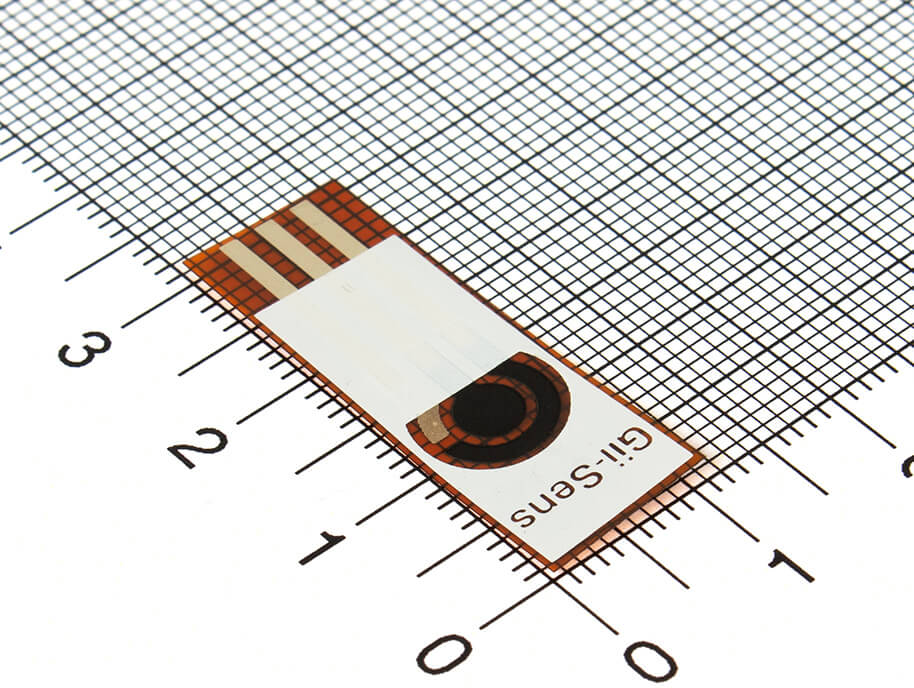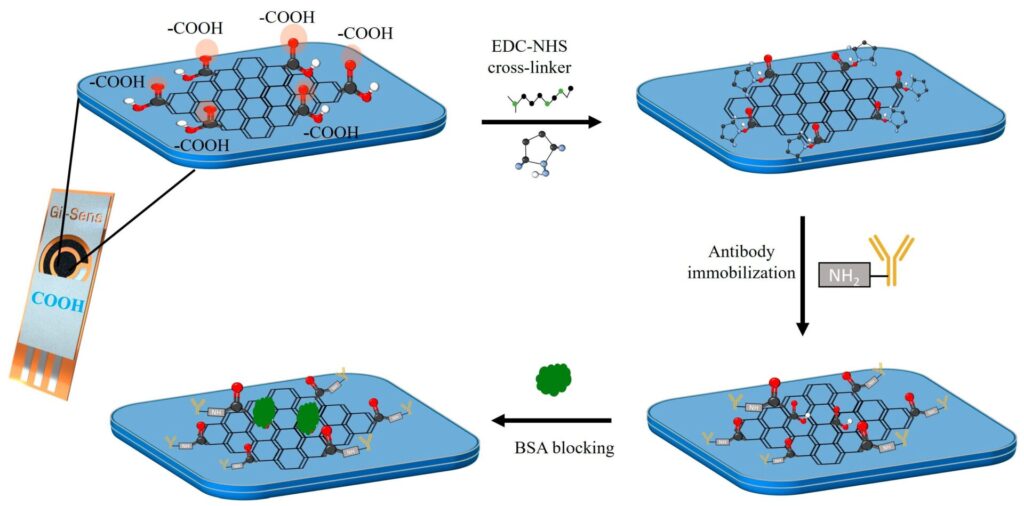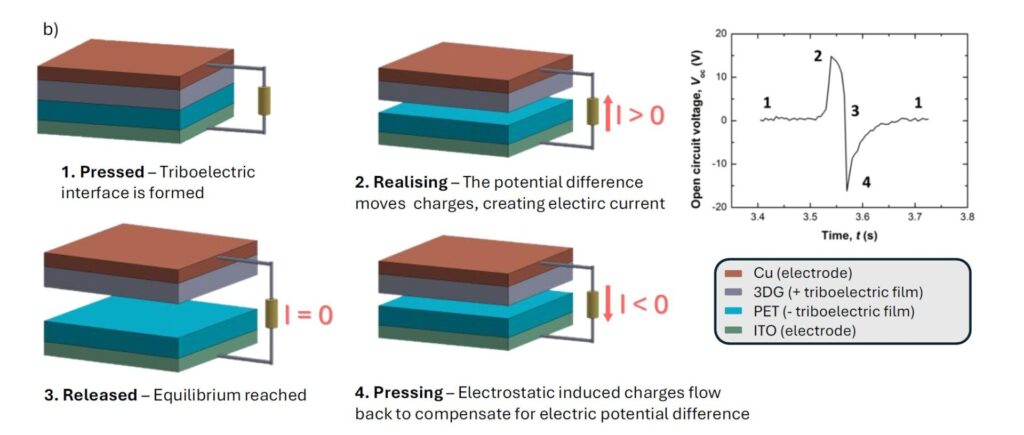
University of Bath scientists develop new battery-free lactic acid sensor using Gii-Sens
- Scientists at the University of Bath, UK, introduce breakthrough carbon-based sensor for detecting lactic acid levels in saliva – avoiding the need for an electrical power source.
- Underpinned by a Gii-Sens electrode platform, the Gii chemosensor could have potential for highly sensitive lactic acid testing in remote locations without needing a lab.
- Applications could include sports science settings, with immediate testing of athletes’ lactic acid levels, and in medical care, such as tracking heart conditions.
- New design potentially offers lower cost, better shelf-life, and ease of miniaturisation compared to enzyme-based sensors.
22 May 2024 – Scientists at the University of Bath, United Kingdom, working in collaboration with industrial partner, Integrated Graphene, have created a new type of chemosensor (demonstrated for lactic acid sensing) which functions with electricity but without the need for reference electrodes or battery power.
The sensor was proven to detect lactic acid, a byproduct generated by the body when it metabolises carbohydrates or glucose for fuel, for example, during exercise. High levels of lactic acid are linked with higher risks of falling unconscious or into a coma and major organ failure.
This opens up the possibility for an easy-to-use sensor to be used in remote locations, such as an athletics track, without the need for electricity-powered sensing equipment.
Currently, lactic acid is often measured with an enzyme test, which has a limited shelf life and requires battery powered sensing equipment. The new type of chemosensor, detailed in a paper published in ACS Sensors, instead measures lactic acid with a chemical method using a graphene foam electrode surface.
Referenced as ‘Graphene Foam’ in the paper, Gii-Sens, the technology underpinning the chemosensor, is an electrode produced by Integrated Graphene. Gii-Sens incorporates Gii™, a pure, porous, 3D carbon nanostructure that delivers low cost and avoids the use of unsustainable noble metals like gold.
When lactate binds to the sensor, it causes a change in the electrical signal – or quantum capacitance – of the carbon foam. The foam therefore detects low levels of lactic acid without consuming it by measuring changes in the electrical charging of Gii, allowing the monitoring of changes in levels. As it is a chemical rather than an enzyme-based sensor, it has a potentially lower cost, better shelf-life, and ease of miniaturisation.
Professor Frank Marken, lead author of the study at the University of Bath, said: “Just as your contactless credit card doesn’t need an external power source to work because the proximity of the card reader is enough to power it – in a similar way, this sensor could create a small, measurable electrical current when lactate binds to it.”
“This sensor, using Gii-Sens technology, addresses some of the main limitations with non-wireless current lactic acid enzyme tests,” said Professor Marken, “It will allow for a more simply operated sensor – opening up the potential for more regular, less invasive and more reliable tracking of lactic acid, even during athlete performance.”
Lactic acid tests have a number of important applications. In professional sports, lactic acid is tested to assess the athlete’s response to different intensities and training regimes. By wirelessly tracking and subsequently improving the body’s ability to transport and utilise lactate, athletes aim to improve their endurance and recovery. It is also used in medical care to track heart conditions like myocardial infarctions, atrial fibrillation, and atherosclerosis. This is useful as elevated lactic acid levels can reduce the heart and blood vessel’s ability to contract, impacting the hemodynamics for regular function.
Jean-Christophe Granier, Chief Executive Officer of Integrated Graphene, commented: “This development is another clear use case of Gii-Sens being integrated into sensing products and offering versatile applicability.”
“The researcher’s test results using our Gii Sens electrode opens up the possibility of more accessible and reliable health monitoring in remote environments and we look forward to putting our highly sensitive Gii-Sens electrode at the heart of more groundbreaking innovations in the point of care diagnostics market.”
Notes to editors:
Media enquiries
For further information, please contact:
Integrated Graphene
Max Kelly
Williams Nicolson
+44 (0)7590 120 533
max.kelly@williamsnicolson.com
University of Bath
Vicky Just
+44 (0)7966 341 357
v.j.just@bath.ac.uk
Research paper
Simon M. Wikeley, Jakub Przybylowski, Jordan E. Gardiner, Tony D. James, Philip J. Fletcher, Mark A. Isaacs, Pablo Lozano-Sanchez, Marco Caffio, and Frank Marken* (2024) “Pyrene-Appended Boronic Acids on Graphene Foam Electrodes Provide Quantum Capacitance-Based Molecular Sensors for Lactate” is published in ACS Sens. 2024, 9, 3, 1565–1574 https://doi.org/10.1021/acssensors.4c00027
University of Bath
The University of Bath is one of the UK’s leading universities, with a reputation for high-impact research, excellence in education, student experience and graduate prospects.
We are ranked 5th in the UK in the Complete University Guide 2024, 6th in the Guardian University Guide 2024 and 8th in The Times and Sunday Times Good University Guide 2024. We are also ranked among the world’s top 10% of universities, placing 148th in the QS World University Rankings 2024. Bath was rated in the world’s top 10 universities for sport in the QS World University Ranking by Subject 2023.
We produce some of the world’s most job-ready graduates and were named University of the Year for Graduate Jobs by the Daily Mail University Guide 2024, as well as ranking as one of the world’s top 90 universities for employer reputation according to the QS World University Rankings 2024.
Research from Bath is helping to change the world for the better. Across the University’s three Faculties and School of Management, our research is making an impact in society, leading to low-carbon living, positive digital futures, and improved health and wellbeing. Find out all about our Research with Impact: https://www.bath.ac.uk/campaigns/research-with-impact/
Integrated Graphene
Integrated Graphene manufactures Gii, a pure 3D carbon nanomaterial with novel properties that can revolutionise product performance across a wide number of sectors. Its first product to market is Gii-Sens, a world leading electrochemical electrode offering a more sensitive, environmentally friendly, and affordable sensor. Integrated Graphene is based in Stirling, Scotland.


